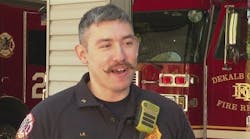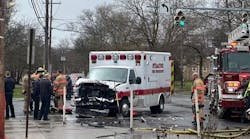Critical Communications Failure
Turn back the clock to 1988 and let's review one of our darkest firefighter tragedies that reinforces the need for effective communications under stress. A building that houses an automobile dealership had a working fire in the attic area. Dreadfully, the building construction included a bow string truss roof assembly that was waiting to collapse on five unsuspecting firefighters inside the structure. The incident commander decided to be "mobile" during this entire alarm. Among the negative results that this improper decision had on this incident (as reported in the detailed post incident analysis1) was very poor (non-existent) communications. In fact, the investigator summed up the communication process by reporting that "?there was a lot of talking at this fire, but no communications?"2.
The heart pounding audiotape records the voice of a senior company officer calling to "command" for help. The voice is strong, clear and very specific about their location and help that he needs to be rescued from certain death. This company officer further describes that he and one other member (a fire fighter) are trapped and are running out of air. The Lieutenant calls out to Command more than 30 times over approximately a 15-minute period for assistance. Because of the "mobile", hands-on approach selected by the IC, the pleas for help go unheard and unheeded. Captured on videotape, the IC's portable radio is seen worn around his hip and too far away from his ears to hear these critical radio transmissions.
As the Lieutenant is completely out of air and still requesting help, a police officer calls the communications center to report the event that he has been listening to and he knows that command ("the scene"3) is missing this most vital information. Once again, the incident review describes the rescue efforts for all five members as "too little, too late"4. Of the five fire fighter fatalities, the two members trapped in the closet space died of asphyxiation according to the medical examiners report. If there was ever an incident that would drive home the need for proper and effective communications under stress, this should be our "poster child" event.
A World Class Success Story
By contrast, one year before this tragic incident, United Airlines pilot Captain Al Haynes is at the controls of a DC-10 jumbo jet. Captain Haynes is the command pilot in charge of a flight that originates in Los Angles and is headed for Chicago. All is calm aboard this gleaming beautiful "ship of the skies", until the unthinkable occurs. The number two Pratt - Whitney jet engine (center topside engine on this model) comes apart. A turbine fan blade disintegrates causing great damage to the aft section of this enormous airplane loaded with 292 people on board. The damage is so severe that all three separate, redundant and independent hydraulic systems are severed. Most unfortunately for Captain Haynes and all, a DC-10 must have hydraulic power to fly and stay aloft (or so it was thought).
Captain Al Haynes knew that this once "agile bird" was headed to a non-survivable high impact crash. Not satisfied with those prospects, Captain Haynes would go on that day to distinguish himself (along with his crew) as a hero and performed the nearly impossible feat of getting the jumbo jet on the ground in a fashion that would be survivable by most of the people aboard. To the amazement of everyone, only 112 people perished that July day leaving 180 folks to tell about their unbelievable ride.
7 Elements of Effective Communications
Among the human factors items that went exceptionally right that day was the communications process between "United 232 Heavy" and the Sioux City Air Traffic Control Tower. The voice transcript that was recorded by the "black box" is a study, in itself, of outstanding communications under the most stressful conditions imaginable. Throughout this whole ordeal, both the sender and receiver, of a lot of critical information stayed connected, cool, calm and always attempted to improve the eventual outcome (critical decision making - more in a future article). Both Captain Haynes and the Sioux City Tower controller used all of the proper communications techniques during this 41-minute exchange of thoughts. Among the processes used to communicate so effectively were:
1) Communications order model2) Self control (calm, clear, concise, etc.)3) Regular updates and reports4) Standardized language5) Consistent Approach6) Great listening skills7) In the correct position to communicateThe Order Model
The communications order model is the process that allows for both the sender and the receiver to "fully understand" a message. Knowing that "complete communications" is very difficult to achieve, the order model asks the receiver to confirm the message / instructions by briefly restating the information. Then the sender gets a final opportunity to verify the message is understood correctly by confirming correct readback the message. To insure that this concept is understood by the reader (purpose of the communications order model) let's try a simple example:
Command: "Command to Paramedic Engine 10"PE-10: "Paramedic Engine 10, go Command"Command: "Paramedic Engine 10, 3 inch supply 1 ? attack line to first floor kitchen area"PE-10: "Paramedic Engine 10 copies, 3 inch supply, 1 ? attack first floor kitchen"Command: "Affirmative Paramedic Engine 10"If, at any time, the message needs to be corrected or restated for clarity, the communications order model handles this situation very easily.
Self Control
Proper and effective communication also relies heavily on self-control and personal discipline. To recall a very important and appropriate adage, "?first you loose your head and then you loose your a-- ?". We are not sure where this saying came from, but it hits the nail on the head for this segment of effective communications. Another fairly well known phenomena is that if the boss can't control him / herself, the subordinates in the system will be hard pressed to keep their emotions under control and be an effective communicator.
All members that use a fireground radio need to be clear and concise with all of their radio messages. This is a simple concept to say, teach, and write, but sometimes it is difficult to put into practice. With most policy / human factors interface, proper and on-going training is the critical link in the success chain. Most every community college course in broadcasting (or other media related field) offers a program or two that deals with speech and communications. From voice coaching to proper breathing techniques, this area of study is very effective in improving how one sounds / looks through a communications medium. This type of training needs to be added into our basic fire officer curriculum. Think about it, it would improve performance at emergencies and prepare us for PIO duties at the same time.
Regular Updates
Effective communications under stressful conditions must include regular and timely updates. When a company / sector is assigned a specific task, they must follow-up with on going progress reports until completion or termination. A sound rule of thumb is to expect or ask for situational updates every ten minutes or even more frequently if the members performing the tasks are in an IDLH (immediately dangerous to life and health) atmosphere. Further, call for PAR's (personnel accountability reports) from IDLH situations every ten minutes or less as well. May sound like a lot of extra radio traffic, but a great deal of bad things can happen in ten minutes during difficult operations.
Command systems need to include a way to account for all of the members at an incident all of the time. All of the accountability systems in use today require some level of communications between operating units and their supervisors, again regular reporting and updates are a must. A time keeping element has to be injected into the reports and updated progress information. Consider having your Communications Center (Alarm Room) broadcast "on-scene notifications" every ten minutes, or consider using available computer software that can "cue" the incident commander with time prompts as desired (set and adjust the prompt on a call by call basis). Think about it, we need to know progress, conditions, PAR and building / container stability throughout the duration of an emergency. These requirements demand that regular and timely updates be provided throughout the incident.
Standardized Language
A key tenant of the incident command system is that common terminology and "plain text" be used rather than complicated "10-codes". This factor is a shared trait between "ICS and CRM". The belief here is that by using common terms, organizations can work internally and externally at a higher level of understanding / communications.
The glaring obvious example about the need for common terminology (standard language) is the comparisons of various "10 code" terms. Typically, the police have a different system as compared to the sheriff's office as compared to the fire department. To add to the confusion of the "10 code system" is the notation of the time by the dispatch center; "is that a 10-32 or is it 10:32?" The argument is that the coded messages free up radio time and provides a level of security keeping the transmitted information from the bad guys or media. Most bad guys and nearly all of the media have better radios than most response agencies. Further, every reporter is assigned a radio and cell phone (with a "10-code" chart). Again they can beat us at the numbers / quality game. The driving force behind a communications system is that it should be accurate and completely understood by all.
Great Listening Skills
In order to be a good communicator (even an average one), you must be a good listener. In speech class, the first day is spent on talking about the basic communications process consisting of a sender and receiver. The process requires at least an equal part of both listening and talking to be able to effectively communicate. Most experts would point out that the listening function is critical and that most people are poor at this skill at best. CRM adds a second or even third set of ears to increase the possibility of getting the message correct the first time, every time.
Consider adding or using radio headsets at your command post. This piece of equipment helps the IC (and team members) to focus on listening to all of the messages that are being transmitted under difficult conditions while members are in dangerous positions. Outside distractions are somewhat removed by the use of this device, most departments use a single ear piece headset so that face to face communications can still be used. To support the listening process, put your command team into the best (sane) position to communicate / command.
Correct Position to Communicate
There is a strong belief that the member needing to transmit critical information via radio, needs to be in the best location to do so. The analogy would be the air traffic controller (the voice behind ATC) is seated at a comfortable and quiet (as much as possible) desk. This office space is properly lit and temperature controlled. When a critical decision is necessary, the FAA has figured out that the more barriers / distractions that are eliminated, the higher the performance of the brains behind the voice. Command post facilities need to resemble the best office space reasonably attainable, so that the commander can "think" to be able to meet the needs of the incident.
Some schools of thought would have the incident commander out in the elements, experiencing the same environmental assault as the troops. The belief is that the IC needs to have first hand knowledge of just how tough conditions are on the workers. This concept would make about as much sense as having the air traffic controller working out on the dark, foggy, cold and noisy runway using a flashlight and cell phone. It would be easy to see the foolishness in such logic, but there is no difference comparing the desire to put the commander out in the weather. One critical element that must be factored into a command post facility is the ability to be out of the weather (no exceptions), where the boss can have a chance to keep his / her sanity.
Communications under stressful conditions is not new to the fire - rescue business. As you can tell by the above case study, we have had our share of tragedies due (in part or whole) to communications failures. The CRM process addresses this critical element of the emergency operation and provides the needed skills, knowledge and abilities whereby communications (and all aspects of human performance) can be greatly improved. Always keep in mind the seven components that are necessary for effective communications. These items are:
In the next article in this series we will take and in-depth look at how "CRM" tools can help emergency responders to improve their operational teamwork / leadership skills. Until next time, be safe out there!
Related:





